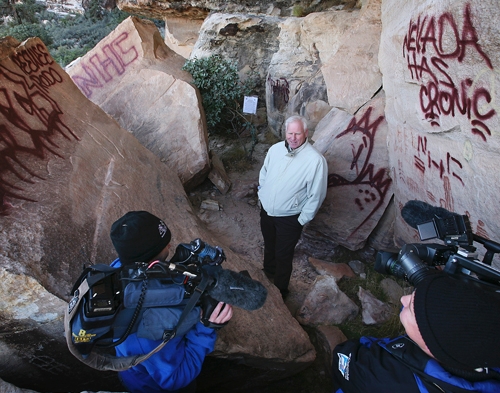1,000-year-old art ruined in just a few minutes


Artistic symbols painted by American Indians had endured for 1,000 years in the northwest end of Red Rock Canyon until about a month ago, when vandals in just a few minutes marred the Aztec sandstone panels with maroon spray paint.
"I would say not all graffiti is bad, but to place graffiti over rock art crosses a different threshold," Bureau of Land Management archaeologist Mark Boatwright said Tuesday of the rock shelter that he thinks was used for centuries by Southern Paiute and Colorado River tribes and their ancestors.
"It’s just sad," he said. "There are a lot of people who are angry. All it takes is one person to screw it up for everybody."
BLM Law Enforcement Ranger Robert Mitsuyasu said investigators are checking out leads and tips received since the graffiti was reported about two weeks ago. Because the investigation is ongoing, he said, he is not at liberty to comment.
A BLM spokeswoman, however, said there were no suspects for the felony crime, which carries a penalty of up to $100,000 and five years in prison for violating the Archaeological Resources Protection Act.
Photographs released Monday and published by several news outlets show 2-foot-tall letters, "NHC," in relatively fresh maroon spray paint. The names "PeeWee" and "Rodo" appear in the same paint on a rock face across from the shelter wall, where more graffiti appears just above several ancient pictographs, or symbols, painted by native Americans.
"Just because you see somebody’s name doesn’t mean they’re responsible," Boatwright said.
Based on other evidence along Lost Creek Trail, Boatwright said he thinks as many as three people might have been involved in the vandalism. Another name, "Bones," is painted in small letters on a sign near the trail.
Even though the initials "NHC" are spelled out as "Nevada Has Chronic" on one vandalized panel, the same initials stand for "Nasty Habits Crew" in a YouTube video that features graffiti in Las Vegas.
Mitsuyasu acknowledged that investigators are aware of the NHC video posting, but he wouldn’t comment on whether it has been linked to graffiti left at the ancient rock art site.
The ancient artists used a type of iron called hematite that Boatwright said is mixed with a binding liquid such as blood, water or urine to give the paint longevity.
In the corner of one rock slab that apparently collapsed from the shelter’s ceiling long ago is a single etching, or petroglyph, that depicts a figure similar to an arched window divided into six sections. Because of its position just above the soil, an observer who monitors the site believes the petroglyph was etched before the slab separated and fell from the ceiling, exposing the area where pictographs were painted later.
Boatwright believes the pictographs to be 1,000 years old based on artifacts found nearby and the archaeological setting, but the earliest petroglyphs in Southern Nevada probably go back as far as 4,000 years.
"Nobody can date rock art, and we don’t know what it means," he said.
Clark County has about 400 archaeological sites, of which 200 are on public lands managed by the BLM. About 560 volunteer stewards routinely monitor the sites four to 16 times each per year.
Records kept by site stewards show the rock shelter site off Lost Creek Trail was for the most part untarnished through the last week of October.
A hiker discovered fresh maroon spray-paint tags in the first week of November, but it took him about a week to report it in an e-mail to authorities, Boatwright said.
Chuck Williams, cultural resources chairman for Friends of Red Rock Canyon, said the mood among members since the damage was revealed has varied from anger to disappointment to a sense of loss.
"We have recorded this site in photos and drawings, but it doesn’t replace the real thing," he said.
The Friends of Red Rock Canyon and the Conservation Lands Foundation are offering a $2,500 reward for information that leads to the conviction of the suspect or suspects.
Bureau of Land Management officials estimate the cost of restoring the site will be $10,000.
Contact Keith Rogers at krogers@reviewjournal.com or 702-383-0308.
Graffiti left at ancient rock art siteMORE INFORMATION
Anyone with information about the vandalism can call the BLM Law Enforcement Hotline at 515-5151.
Information about making donations for a reward or the restoration effort can be found at friendsofredrockcanyon.org.












